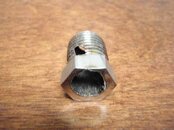Curt Bowen
Contributor
Did his family die early from second hand smoke?I am really surprised to hear you say that. The logic behind O2 cleaning is to reduce the probability of a fire by removing contaminates. You are just one data point. My uncle used to smoke 2 packs of Lucky Strikes a day for decades, lived into his mid 90s and never had problems with his lungs. His experience doesn't mean that cigarettes are safe.
Sent from my SAMSUNG-SGH-I337 using Tapatalk




